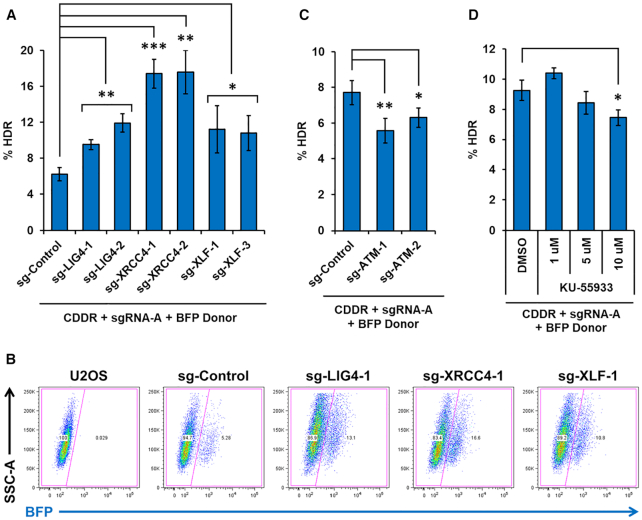Figure 8.
DNA Ligase IV, XRCC4, and XLF suppress HDR, whereas ATM promotes HDR. (A) Percentage of cells with single DSBs repaired via HDR (% BFP+ cells) following DSB induction and subsequent repair in the presence of a BFP cDNA donor template in U2OS-CDDR-Clone-1 cells and clonal derivatives deleted of LIG4, XRCC4, or XLF. Data represent the mean of three independent experiments ± s.d. Statistical significance was determined using two-tailed Student's t-test; *P< 0.05, **P< 0.01, ***P< 0.001. (B) Representative FACS profiles of U2OS cells, U2OS-CDDR-Clone-1 cells, and clonal derivates of the latter deleted of LIG4, XRCC4, or XLF, following the induction of single DSBs and subsequent repair in the presence of a BFP cDNA donor template. (C) Percentage of cells with single DSBs repaired via HDR (% BFP+ cells) in U2OS-CDDR-Clone-1 cells and clonal derivatives deleted of ATM. Data represent the mean of three independent experiments ± s.d. Statistical significance was determined using two-tailed Student's t-test; *P< 0.05, **P< 0.01. (D) Percentage of cells with single DSBs repaired via HDR (% BFP+ cells) in U2OS-CDDR-Clone-1 cells treated with DMSO or increasing doses of ATM-specific inhibitor KU-55933. Data represent the mean of three independent experiments ± s.d. Statistical significance was determined using two-tailed Student's t-test; *P< 0.05.

